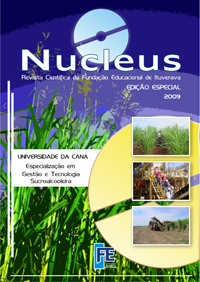PANORAMA DA COLHEITA MECANIZADA DE CANA-DE-AÇÚCAR E SEU IMPACTO NO MANEJO DA CULTURA
DOI:
https://doi.org/10.3738/nucleus.v0i0.136Keywords:
Cana-de-açúcar, colheita mecanizada, colheita semi-mecanizada.Abstract
Nowadays, sugar cane (Saccharum officinarum L.) occupies 6.96 millions of hectares in Brazil and there is an estimate to crush 475.07 millions of tons, from among, 47% are for sugar production, whereas 53% are for alcohol production. Among all the stages of sugar cane production, the harvest time is the phase which presents more changes due not only to the new socio-environmental demands, but also to the need for cost reduction. The semi-mechanized harvest system involves a great number of workmanship and requires the use of canebrake burning, practice condemned by society and that has been forbidden by an increasing number of municipality producers of sugar cane and by state law. As an alternative to the canebrake burning, it has been adopted the mechanized harvest system. In this system it is used self- propelled harvesters that cut and grind the leaves, as well as the sheathing part and the apex of them, besides a great variable quantity of parts of a stem, and afterwards these parts are thrown to the soil forming a cover of vegetal residue called straw or fodder. The mechanized system provokes a series of changes while handling the culture because it causes a great accumulation of straw on the surface of the soil which modifies the control of the weed and makes it difficult to the second harvest of sugar cane to sprout again, besides retaining the soil humidity for a longer period and modifying the fauna considered as the culture plague. The operational performance is also affected because one harvester is able to substitute 80 men per day and the changing process requires the workmen’s qualification and the adequacy of the fleet of sugar cane trucks as well. Thus, the objective of this work is to carry out a survey on scientific researches that are being accomplished about the impact of the handling of the culture caused by the process of changing from the semi-mechanized harvest system to the mechanized sugar cane culture.Downloads
Published
2009-03-27
Issue
Section
Universidade da Cana-FMC
License
À revista se reserva o direito de efetuar, nos originais, alterações de ordem normativa, ortográfica e gramatical, com vistas a manter o padrão culto da língua, respeitando, porém, o estilo dos autores. A provas finais não serão obrigatoriamente enviadas aos autores. Os trabalhos publicados passam a ser propriedade da revista. As opiniões emitidas pelos autores dos artigos são de sua exclusiva responsabilidade.How to Cite
PANORAMA DA COLHEITA MECANIZADA DE CANA-DE-AÇÚCAR E SEU IMPACTO NO MANEJO DA CULTURA. (2009). Nucleus. https://doi.org/10.3738/nucleus.v0i0.136


